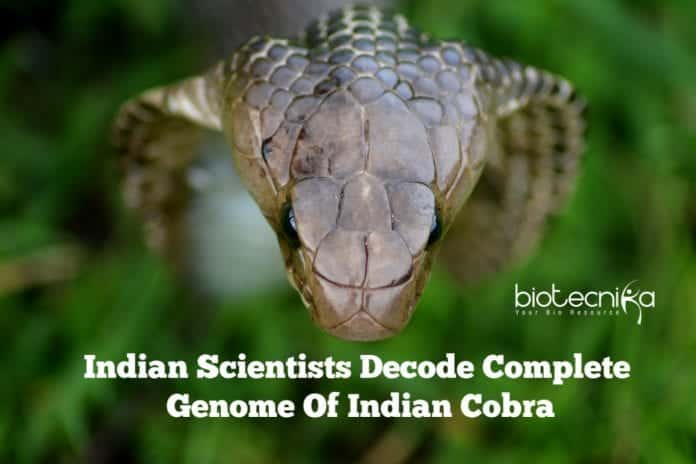Indian Cobra Genome Sequenced – Can Aid In Developing New Antivenom
A team of Indian scientists and their collaborators abroad have successfully sequenced the genome of the highly poisonous Indian Cobra, in a step taken to reduce the disability and mortality caused by snake bites.
Among the most venomous four snakes in India, which are called collectively as the infamous “big four”, the Indian cobra is the most venomous Indian snake to be genetically mapped. In India, everywhere, nearly 46,000 deaths occur due to snakebites from the four venomous snakes, the Indian cobra, saw-scaled viper, Russell’s viper, and common krait. Around 5.4 million snake bites occur every year worldwide, with 2.8 million of them in India. Globally, they are responsible for 4,00,000 disabilities, of which from India there are around 1,38,000 disabilities.
The President of the Chennai-based SciGenome Research Foundation (SGRF), Sekar Seshagiri and the scientists led by him have assembled the most contiguous genome of the cobra, using a mix of cutting-edge genomic technologies. Experts say that this will help in developing more efficient antibodies.
Scientists found in the present study that there are 19 toxin genes primarily expressed in the venom glands of the Indian cobra. Seshagiri said
” For treating Indian cobra bites, using synthetic human antibodies to target these toxins should lead to a safe and effective antivenom. We will be able to generate antibodies (antivenom) to the other three venomous snakes and develop an anti-venom quickly if we get one good antivenom against the Indian cobra and genome sequences from the other three.Researchers from US firm Genentech, MedGonome Labs and SGRF’s AgriGenome Labs, Wayanad Wildlife Sanctuary in Kerala and their peers from many universities in the US and Singapore participated in the study, along with Seshagiri’s team.
Outdated procedure
Antivenom that is currently in use is based on a process developed over 100 years ago and is produced by immunizing horses with extracted snake venom. This process suffers from a lack of consistency leading to serious side-effects and varying efficacy and ent also is a laborious process.
An author of the study, R Manjunatha Kini, Professor, National University of Singapore (NUS), Singapore said ” It is high time that we develop antivenom leveraging modern technologies like synthetic antibody development technologies, recombinant protein expression, and genomics. We have the blueprint needed to this from the Indian cobra genome and the catalog of target toxins. Venom also serves as a significant source of drug-like molecules. The genome of Indian cobra is no exception and it codes for toxin molecules that prevent blood clotting, reduce blood pressure and block pain.
Universal antivenom
The Chief Operating Officer of AgriGenome Labs, George Thomas said “The Indian cobra is the first snake to be sequenced among the ‘big four’ deadly snakes. This can effectively change the way antivenom is developed and is a major step towards understanding its venom components.”
Using this genomic blueprint for venom toxins to make recombinant proteins, to generate neutralizing antibodies and test them in the clinic would be the next step, said the scientists. Eventually, a universal antivenom can be developed by further sequencing other snake genomes and the information on additional toxins from these snakes that need to be targeted will be provided by the venom glands.
They said, “In less than 2-3 years and by testing in trials rapidly, we believe we can produce a synthetic humanized antivenom.”
A researcher with the Indian Institute of Science, Bengaluru, Karthik Sunagar said “With the state-of-the-art sequencing technologies, this is the first genome of Indian snake to be sequenced. Such a high-quality genome will be a great resource for understanding the evolution of this medically important snake and its venom repertoire and it could also be very beneficial for the next-generation recombinant antivenoms’ innovation.”






























